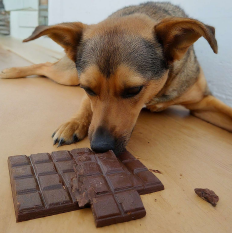
Chocolate is often referred to as a treat for humans, but it can be a source of significant danger for dogs. Pet owners need to be aware of the risks associated with chocolate consumption in dogs and how to prevent such incidents. This article delves into why chocolate harms dogs, the symptoms of chocolate poisoning, and what to do if your dog ingests chocolate.
Why Is Chocolate Dangerous for Dogs?
Chocolate contains substances called theobromine and caffeine, both of which are toxic to dogs. These
compounds belong to the methylxanthine class of chemicals, which can have a stimulating effect on the
central nervous system and cardiovascular system. While humans can metabolize these substances
relatively quickly, dogs process them much more slowly, allowing the toxins to build up to harmful levels.
Theobromine Toxicity
The primary toxin in chocolate that affects dogs is theobromine. Dogs cannot metabolize theobromine
efficiently, leading to potential poisoning. The severity of the symptoms depends on several factors,
including the type and amount of chocolate consumed, as well as the size and breed of the dog.
Types of Chocolate and Their Theobromine Content
poisoning, but it’s sƟll not recommended due to its high fat and sugar content.
be harmful, especially in large amounts.
dogs.
small quantities.
Symptoms of Chocolate Poisoning in Dogs
The symptoms of chocolate poisoning in dogs can vary based on the amount and type of chocolate
ingested. Common signs include:
1. Vomiting: This is often one of the first sings and can occur within a few hours of ingestion.
2. Diarrhea: Along with vomiƟng, diarrhea is a common gastrointestinal response.
3. Restlessness or Hyperactivity: Theobromine can cause excessive excitement or agitation.
4. Increased Heart Rate: Elevated heart rate or arrhythmias can occur due to the stimulating
effects of theobromine.
5. Muscle Tremors or Seizures: In severe cases, dogs may experience muscle tremors or seizures.
6. Panting: Excessive panting is a sign that the dog may be experiencing distress.
7. Excessive Thirst or Urination: Theobromine acts as a diuretic, leading to increased thirst and
frequent urination.
8. Rapid Breathing: Difficulty in breathing or rapid breathing can be a sign of more severe
poisoning.
If you suspect your dog has ingested chocolate, it’s crucial to seek veterinary care immediately, even if
symptoms have not yet appeared.
What to Do If Your Dog Eats Chocolate
If you catch your dog in the act of eating chocolate or find out afterward that they have ingested it, take
the following steps:
1. Determine the Type and Amount: Identify the type of chocolate and estimate how much your
dog has consumed. This informaƟon will help the veterinarian assess the risk and determine the
appropriate treatment.
2. Contact Your Veterinarian: Reach out to your vet or an emergency animal poison control hotline
immediately. Provide details about the type and amount of chocolate consumed and your dog’s
weight.
3. Induce Vomiting (if instructed): In some cases, your veterinarian may recommend inducing
vomiting to prevent further absorpƟon of theobromine. This should only be done under
professional guidance.
4. Monitor Your Dog: Keep an eye on your dog for any signs of distress or symptoms of poisoning.
Be prepared to provide this informaƟon to your vet if needed.
5. Follow Veterinary Advice: Follow any instrucƟons provided by your veterinarian. This may
include bringing your dog in for an examination, administering activated charcoal to limit toxin
absorption, or providing supportive care.
Prevention is Key
The best way to protect your dog from chocolate poisoning is to prevent access to chocolate altogether.
Here are some preventive measures:
1. Store Chocolate Safely: Keep chocolate and chocolate-containing products out of your dog’s
reach. Store them in sealed containers and on high shelves.
2. Educate Household Members: Ensure that everyone in your household understands the dangers
of chocolate for dogs and avoids sharing chocolate with pets.
3. Be Cautious with Holiday Treats: During holidays and special occasions, be mindful of chocolate
gifts and treats. Keep them away from pets and dispose of any wrappers or leftovers promptly.
FAQs
Q: What should I do if my dog eats chocolate but doesn’t show symptoms?
A: Even if your dog is not showing symptoms, it is important to contact your veterinarian immediately.
Theobromine poisoning can have delayed effects, and early intervenƟon can be crucial.
Q: Can dogs die from eating chocolate?
A: Yes, chocolate poisoning can be fatal, especially if a large amount is consumed or if the dog receives
delayed treatment. The severity of the outcome depends on various factors, including the type and
amount of chocolate ingested.
Q: How can I estimate the risk of chocolate poisoning?
A: The risk of chocolate poisoning depends on the type of chocolate, the amount consumed, and the size
of your dog. There are online chocolate toxicity calculators that can provide an esƟmate, but consulƟng a
veterinarian is always recommended.
Q: Are there any safe treats I can give my dog?
A: Yes, there are many safe and healthy treats designed specifically for dogs. Opt for treats made from
dog-friendly ingredients and avoid giving human foods that are toxic to pets.
Q: How can I ensure my dog’s safety during holidays or parƟes?
A: During holidays or parƟes, be vigilant about where chocolate and other potentially harmful foods are
kept. Inform guests about the dangers of feeding chocolate to dogs, and have pet-safe treats available
for your furry friend.
In summary, while chocolate is a delighƞul treat for humans, it poses serious risks to dogs. By
understanding the dangers, recognizing the symptoms of poisoning, and taking preventive measures,
you can ensure your canine companion stays safe and healthy. Always err on the side of cauƟon and
consult your veterinarian if you suspect your dog has ingested chocolate.
